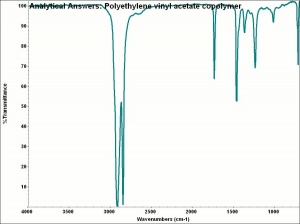Difference between revisions of "Ethylene vinyl acetate"
| (One intermediate revision by the same user not shown) | |||
| Line 6: | Line 6: | ||
E/VAC; ethylene-vinyl acetate (AAT); EVA; VAE; polyethylene/polyvinyl acetate; poliacetato de vinilo-polietileno (Esp.); Airflex (formerly Aircoflex) [Air Products and Chemicals]; Dur-O-Set; Elvace [DuPont]; BEVA; Ultrathene [USI]; Vinnapas [Wacker Chemie]; Mowilith [Hoechst]; Evazote® [Zotefoams]; | E/VAC; ethylene-vinyl acetate (AAT); EVA; VAE; polyethylene/polyvinyl acetate; poliacetato de vinilo-polietileno (Esp.); Airflex (formerly Aircoflex) [Air Products and Chemicals]; Dur-O-Set; Elvace [DuPont]; BEVA; Ultrathene [USI]; Vinnapas [Wacker Chemie]; Mowilith [Hoechst]; Evazote® [Zotefoams]; | ||
| − | |||
| − | |||
== Personal Risks == | == Personal Risks == | ||
| Line 17: | Line 15: | ||
May release acetic acid, especially at elevated temperatures. | May release acetic acid, especially at elevated temperatures. | ||
| − | == Physical and Chemical | + | == Physical and Chemical Properties == |
[[[SliderGallery rightalign|aaiPE-EVAhotmelt.jpg~FTIR]]] | [[[SliderGallery rightalign|aaiPE-EVAhotmelt.jpg~FTIR]]] | ||
| Line 27: | Line 25: | ||
[[media:download_file_379.pdf|Physical Properties for Selected Thermoplastic Resins]] | [[media:download_file_379.pdf|Physical Properties for Selected Thermoplastic Resins]] | ||
| − | + | ==Resources and Citations== | |
| − | == | ||
* Richard S. Lewis, ''Hawley's Condensed Chemical Dictionary'', Van Nostrand Reinhold, New York, 10th ed., 1993 | * Richard S. Lewis, ''Hawley's Condensed Chemical Dictionary'', Van Nostrand Reinhold, New York, 10th ed., 1993 | ||
| Line 36: | Line 33: | ||
* ''Van Nostrand's Scientific Encyclopedia'', Douglas M. Considine (ed.), Van Nostrand Reinhold, New York, 1976 | * ''Van Nostrand's Scientific Encyclopedia'', Douglas M. Considine (ed.), Van Nostrand Reinhold, New York, 1976 | ||
| − | * Art and Architecture Thesaurus Online, | + | * Art and Architecture Thesaurus Online, https://www.getty.edu/research/tools/vocabulary/aat/, J. Paul Getty Trust, Los Angeles, 2000 |
[[Category:Materials database]] | [[Category:Materials database]] | ||
Latest revision as of 16:01, 5 August 2022
Description
A thermoplastic, elastomeric copolymer. Ethylene vinyl acetate copolymers (EVA) are commonly used in packaging applications replacing Polyvinyl chloride as the most used resin. EVA copolymers require no curing or Plasticizer and have no odor. They can be molded and extruded into many shapes and are available as films, sheeting and tubing. EVA copolymers are clear, tough, crack resistant and retain flexibility at low temperatures. Depending on the proportions of each polymer, EVAs soften at about 70C. They are used in paper coatings, shrink-wrap, and hot-melt adhesives. As hot melts, EVAs have been used in the fabrication of storage and travel cases (Hatchfield 2002).
Synonyms and Related Terms
E/VAC; ethylene-vinyl acetate (AAT); EVA; VAE; polyethylene/polyvinyl acetate; poliacetato de vinilo-polietileno (Esp.); Airflex (formerly Aircoflex) [Air Products and Chemicals]; Dur-O-Set; Elvace [DuPont]; BEVA; Ultrathene [USI]; Vinnapas [Wacker Chemie]; Mowilith [Hoechst]; Evazote® [Zotefoams];
Personal Risks
Fisher Scientific: [Safety Data Sheet]
Collection Risks
May release acetic acid, especially at elevated temperatures.
Physical and Chemical Properties
Comparisons
General Characteristics of Polymers
Physical Properties for Selected Thermoplastic Resins
Resources and Citations
- Richard S. Lewis, Hawley's Condensed Chemical Dictionary, Van Nostrand Reinhold, New York, 10th ed., 1993
- Pam Hatchfield, Pollutants in the Museum Environment, Archetype Press, London, 2002
- Van Nostrand's Scientific Encyclopedia, Douglas M. Considine (ed.), Van Nostrand Reinhold, New York, 1976
- Art and Architecture Thesaurus Online, https://www.getty.edu/research/tools/vocabulary/aat/, J. Paul Getty Trust, Los Angeles, 2000
